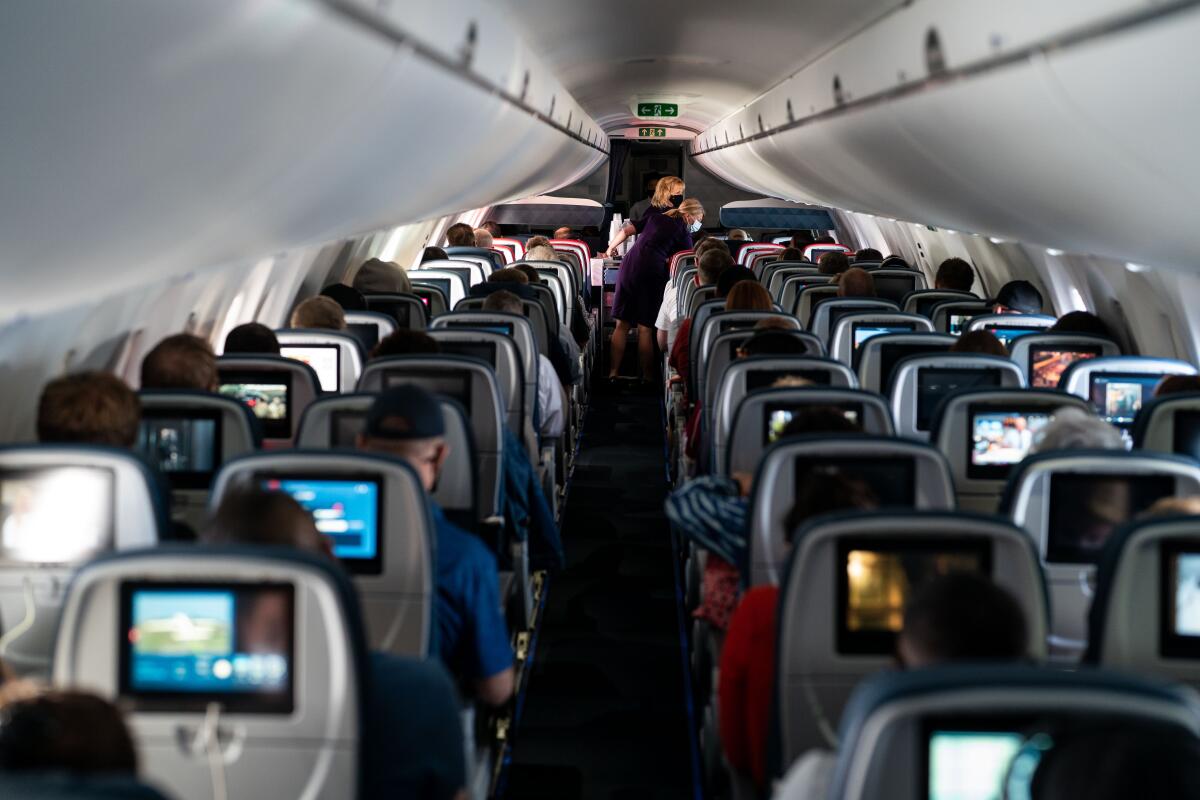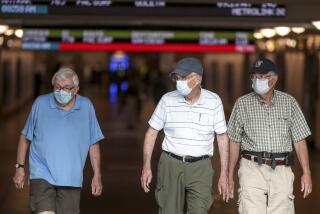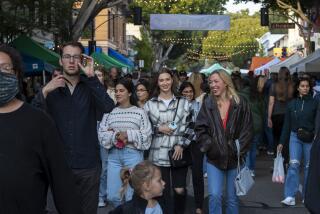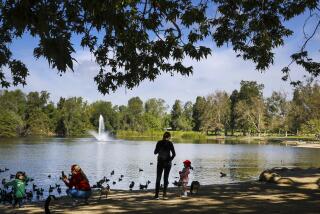How Delta upended California’s economic outlook — from ‘sizzling to ho-hum’

- Share via
Remember when the economic recovery in California and the nation was going to seem like the Roaring ’20s? That was what UCLA forecasters predicted nine months ago.
Remember when it was likely to be “euphoric”? So they said six months ago.
Or when it was expected to be “boom time for the U.S. economy”? That was three months ago.
But the Delta variant of the coronavirus has upended the calculations of forecasters — not just at UCLA Anderson’s widely cited group, but among academic, government and corporate economists nationwide.
The outlook has gone from “sizzling to ho-hum,” the UCLA quarterly forecast, released Wednesday, reported.
“Back in the spring, the economic optimism was palpable,” senior economist Leo Feler wrote. “The U.S. was vaccinating an average of 2 to 3 million people per day. The economy was reopening. Hiring was accelerating. It looked like COVID was finally behind us.”
But with entrenched vaccine resistance and rising deaths in many states, consumers are hesitant to go out and spend on entertainment and restaurants, workers are retiring rather than risk infection on the job, business and international travel are dormant and global supply chains are going haywire as the virus closes factories abroad, Feler said.

“What could have been a couple of years of blockbuster economic growth look instead to become years of good, solid, but not spectacular growth.”
UCLA predicts gross domestic product will grow this year at 5.6%, down from the 7.1% rate forecast in June. It expects the economy to expand by 4.1% next year, down from the 5% anticipated earlier.
As consumption and investment shift into the future, 2023 growth could be 3.1%, up from the previously forecast 2.2%.
California’s recovery from the COVID-19 recession strengthened in August as employers added 104,300 jobs. Unemployment remains high at 7.5%
Not until the third quarter of 2023 would GDP reach its pre-COVID-19 trend, according to the new calculation — assuming, Feler said, that the standoff in Congress over lifting the debt limit is resolved.
“A debt default would be a self-inflicted wound — bad for the economy, but we don’t really know how bad,” he said.
UCLA’s forecast for this year is slightly less optimistic than that of the Federal Reserve, which projects GDP growth at 5.9%, down from its June forecast of 7%. The Fed predicts 3.8% growth next year.
California began recovering later than some other states because of its stricter public health measures, but those interventions will mean the state rebounds faster than the nation over the next three years, UCLA economists Jerry Nickelsburg and Leila Bengali suggest.
As of Sunday, the Golden State had the lowest weekly coronavirus case rate of any state: 83 cases for every 100,000 residents. That compares with 271 cases in Texas and 248 cases in Florida — states with loose regulations.
Another boost to the state’s economy is that the virus has led to more remote work — a factor that benefits its large technology and professional sectors.
The job market will depend on the uncertain course of the pandemic, the forecasters wrote, but they expect California’s employment to rise by 3.5% this year, 3.9% next year and 2.7% in 2023.

That contrasts with projected U.S. employment growth of 3.1%, 3.2% and 2.1% over the same three years.
“Delta has spooked consumers,” Nickelsburg wrote. “News reports on breakthrough [infections] and the large number of Californians not vaccinated will likely push a full recovery into the latter part of 2022.”
Other forecasters are less optimistic. “I don’t expect a full California jobs recovery until late 2023 or even 2024,” said Scott Anderson, chief economist at the Bank of the West in San Francisco. “California’s economic performance won’t be quite as strong as they project with their rosy assumptions around better health outcomes.”
The wealthy state is failing many of its workers, a report commissioned by Gov. Gavin Newsom says, highlighting how California continues to grapple with a starkly unequal economy. It calls for “moonshot goals,” including guaranteed jobs for all Californians who want them.
Seventy percent of jobs lost in California over the course of the pandemic are in three sectors: leisure and hospitality, education and “other services,” a diverse category of businesses such as hair salons and auto repair shops. What they have in common: high person-to-person contact.
Teachers are returning to work, but leisure and hospitality employment “will be the last to recover due to the depth of the decline in this sector, the slower return of restaurant and bar services demand, and the sub-sectors dependent upon international tourism,” Nickelsburg wrote.
In a move to restore confidence, Los Angeles, following the lead of San Francisco and New York City, is considering requiring adults to show proof of full vaccination to enter indoor restaurants, coffee shops, gyms, shopping centers, museums, movie theaters and hair and nail salons.
California’s unemployment rate, traditionally higher than the nation’s partly because of the state’s reliance on tourism, leisure and hospitality, is expected to average 7.6% this year, 5.6% next year and 4.4% in 2023.
In 2019, before the coronavirus hit, Golden State joblessness had dropped to 4.2%.
For the U.S., the forecasters predict unemployment will fall from 5.6% this year to 4.4% next year and 3.7% in 2023, the same as in 2019.
As for complaints about labor shortages, U.S. businesses may be posting 11 million job openings and 8 million people may be unemployed nationwide, Feler said, but “sectors demanding work are different from sectors where people used to work. California may have openings in tech and engineering, but how does that help someone who worked in leisure and hospitality?”
Moreover, he said, “Being a restaurant server before wasn’t a risky job. Now it is. And it is hard to go back to the labor force when your kid might be sent home from school and quarantined for 10 days. You need a job that’s very flexible.”
One bright spot in California is logistics. Asian imports are flooding through the giant ports of Los Angeles and Long Beach and spurring construction of distribution centers across the Inland Empire, buoyed by booming pandemic-related demand for such things as home gym equipment, electronics and furniture, as consumers spend on goods rather than travel, dining and movie tickets.
Golden State transportation, warehousing and utility jobs are forecast to grow at the highest rate of any sector this year: 5.4%, slightly above leisure and hospitality’s 5.3%.
Meanwhile, shipping prices have skyrocketed, dozens of vessels are anchored off Southern California because of logistics bottlenecks, and many imported goods, including windows, semiconductors and automobiles, are in short supply — factors that contribute to inflation.
Many items destined for retailer shelves this holiday season are hopelessly snarled in the global supply chain. What does that mean for shoppers?
“Over the course of this past year, inflation has been higher and price levels have increased faster than at any time in the past 30 years,” according to the UCLA forecast. Average prices won’t come down, it predicts, but the inflation rate will slow from 4.1% year over year in the fourth quarter of this year to 2.7% the same quarter next year and 2.4% in the fourth quarter of 2023.
The pandemic-induced shift from spending on services to buying more goods is coinciding with COVID-related factory shutdowns in Vietnam, Thailand and other producers of U.S imports.
“We’re in a moment of temporary shock,” Feler said. “Even if the U.S. gets vaccinated, people in the rest of the world still aren’t vaccinated — or they may have been inoculated with a less-effective vaccine.
“In a globalized economy, they produce our consumer goods. If they can’t get back to work because of the pandemic, we won’t get the products we want to buy — and that has economic repercussions.”
The pandemic has disproportionately hit lower-income Californians, driving up inequality in the state, according to UCLA’s forecast, which includes a section on Los Angeles, the nation’s most populous county with 10 million residents. The city, with a service-and-tourism-dependent workforce, has been hit especially hard, according to the report by economist William Yu.
Cities with large tourism-based economies have the highest job losses, Yu reports. As of July, Los Angeles payrolls were down by 8.7% from the pre-pandemic level. But others were worse off, with New York, Honolulu, Las Vegas and Orlando, Fla., payrolls down about 10%.
Tax return data show a hollowing out of the middle class in both the U.S. and L.A., with only 23% of U.S. households and 21% of L.A.’s earning middle-class wages, which are defined as an adjusted gross income of $50,000 to $100,000 in 2018, Yu wrote.
More than a third of households in the U.S. and Los Angeles earn less than $25,000 a year.
Inequality is caused by factors including “technology change, globalization, the socioeconomic environment, governmental policies, and immigration,” Yu wrote, but he suggested that inequality in education is the main driver of low wages and poverty.
“Less-educated workers are less likely to find a high-paying job,” he said.
But many Southern California colleges rank among the highest in the nation in the percentage of students from the lowest income levels who reach the top 20% in income later in life, according to one recent study, Yu wrote.
More to Read
Inside the business of entertainment
The Wide Shot brings you news, analysis and insights on everything from streaming wars to production — and what it all means for the future.
You may occasionally receive promotional content from the Los Angeles Times.













